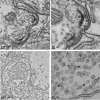Molecular and microscopic evidence of viruses in marine copepods
- PMID: 23297243
- PMCID: PMC3557045
- DOI: 10.1073/pnas.1216595110
Molecular and microscopic evidence of viruses in marine copepods
Abstract
As dominant members of marine mesozooplankton communities, copepods play critical roles in oceanic food webs and biogeochemical cycling. Despite the ecological significance of copepods, little is known regarding the causes of copepod mortality, and up to 35% of total copepod mortality cannot be accounted for by predation alone. Viruses have been established as ecologically important infectious agents in the oceans; however, viral infection has not been investigated in mesozooplankton communities. Here we used molecular and microscopic techniques to document viral infection in natural populations of the calanoid copepods Acartia tonsa (Dana) and Labidocera aestiva (Wheeler) in Tampa Bay, FL. Viral metagenomics revealed previously undocumented viruses in each species, named Acartia tonsa copepod circo-like virus (AtCopCV) and Labidocera aestiva copepod circo-like virus (LaCopCV). LaCopCV was found to be extremely prevalent and abundant in L. aestiva populations, with up to 100% prevalence in some samples and average viral loads of 1.13 × 10(5) copies per individual. LaCopCV transcription was also detected in the majority of L. aestiva individuals, indicating viral activity. AtCopCV was sporadically detected in A. tonsa populations year-round, suggesting temporal variability in viral infection dynamics. Finally, virus-like particles of unknown identity were observed in the connective tissues of A. tonsa and L. aestiva by transmission electron microscopy, demonstrating that viruses were actively proliferating in copepod connective tissue as opposed to infecting gut contents, parasites, or symbionts. Taken together, these results provide strong independent lines of evidence for active viral infection in dominant copepod species, indicating that viruses may significantly influence mesozooplankton ecology.
Conflict of interest statement
The authors declare no conflict of interest.
Figures


References
-
- Honjo S, Manganini SJ, Krishfield RA, Francois R. Particulate organic carbon fluxes to the ocean interior and factors controlling the biological pump: A synthesis of global sediment trap programs since 1983. Prog Oceanogr. 2008;76:217–285.
-
- Small LF, Ellis SG. Fecal carbon production by zooplankton in Santa Monica Basin: The effects of body size and carnivorous feeding. Prog Oceanogr. 1992;30:197–221.
-
- Kleppel GS, Burkart CA, Carter K, Tomas C. Diets of calanoid copepods on the West Florida continental shelf: Relationships between food concentration, food composition and feeding activity. Mar Biol. 1996;127:209–217.
-
- Baird D, Ulanowicz RE. The seasonal dynamics of the Chesapeake Bay ecosystem. Ecol Monogr. 1989;59:329–364.
-
- White J, Roman M. Seasonal study of grazing by metazoan zooplankton in the mesohaline Chesapeake Bay. Mar Ecol Prog Ser. 1992;86:251–261.
Publication types
MeSH terms
Substances
Associated data
- Actions
- Actions
- Actions
- Actions
- Actions
- Actions
- Actions
- Actions
- Actions
- Actions
- Actions
- Actions
- Actions
- Actions
- Actions
- Actions
- Actions
- Actions
- Actions
- Actions
- Actions
- Actions
- Actions
- Actions
- Actions
- Actions
- Actions
- Actions
- Actions
- Actions
- Actions
- Actions
- Actions
- Actions
- Actions
- Actions
- Actions
- Actions
- Actions
- Actions
- Actions
- Actions
- Actions
- Actions
- Actions
- Actions
- Actions
- Actions
- Actions
- Actions
- Actions
- Actions
LinkOut - more resources
Full Text Sources
Other Literature Sources
Research Materials
Miscellaneous

